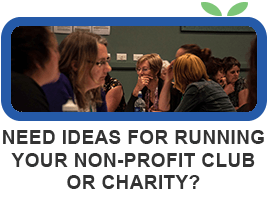Last updated August 20, 2014
Eco-friendly fundraising is not just for organisations with a specific environmental focus. Eco-friendly options often make good financial sense and can help enhance your reputation as a caring, responsible organisation.
While some eco-friendly processes may require a complete change of thinking for your organisation, there are just as many ideas that can be implemented in an instant. The key is being aware of your options and identifying the ones that fit for you.
1. Attitude
As with most things in life, when it comes to adopting enviro-friendly practices you need to start by having the right attitude. If you think being eco-friendly is ‘just for hippies’, or you believe there’s no benefit in making the change, chances are you’ll find plenty of reasons not to do it. By simply becoming aware of your options, you can slowly make changes that fit with your organisation. You just need to be open enough to consider the fit.
2. Goody Bags
Goody bags are a great way to recognise support at a fundraising event and it’s easy to choose an eco-friendly option. To help subsidise the cost, consider selling sponsorship space on the side of the bag. Check out www.simplyjute.co.nz or www.ecobags.co.nz for some cool eco-friendly options.
3. Team Car Pooling
Encouraging your volunteers to car pool to and from work is not only great for the environment; it helps build relationships within your volunteer force. Creating a ‘team culture’ makes volunteering more enjoyable, and therefore your volunteers are likely to stay involved for longer.
Make sure your Volunteer Welcome Packs include the contact details of other volunteers, and highlight those whom live in the same area as your new recruit.
4. Donor Recognition
It is important to recognise your large and long-term donors, however how you give that recognition can vary depending on the situation. Instead of a metal plaque attached to a wall or building, consider planting a tree in recognition of special contributors.
5. Fundraising Products
Selling products is a quick and easy way to raise funds, particularly for organisations with a large membership base. Some of our favourite eco-friendly products are now available as fundraisers for community groups, so in this area of fundraising, it’s easy to go green. Check out www.4myearth.co.nz and www.tradeaid.org.nz for some great product ideas.
6. A Helping Hand
Developing enviro-friendly policies and practices for your whole organisation can be a little daunting, especially if you’re doing it for the first time. Don’t panic – there are plenty of organisations who will help you ‘green up’ your business practices, so you don’t need to do it all on your own. Start by checking out the Sustainable Business Network at www.sustainable.org.nz .
7. Just Enough Brochures
Distributing brochures about your organisation to places such as doctors, libraries and community centres is a great way to raise the profile of your organisation, but make sure you send ‘just enough’ and then top them up as required. Large piles of brochures often get tossed out because the venue has no place to store them. Not only is this bad for the environment, it costs you a lot of money.
Develop a distribution system so that your brochures are always available in public places, without leaving excess copies that end up as trash.
8. Newsletters
Newsletters are an absolutely essential part of your communication with supporters, and in my opinion, hard-copy versions still offer immense benefit to your organisation. Because of this I don’t suggest cutting them out completely, but I do suggest reviewing your newsletters and making sure that all the content is relevant and has a real reason for being there. So often we include information out of habit, but it serves no real purpose to either you or your reader. By keeping your newsletter succinct, you’ll not only save on paper, you’ll create a newsletter that is more likely to produce results.
9. Recycle Bins
Have recycle bins available at your fundraising events and make it easy for people to actually use them. Not only does this help the planet, it keeps your rubbish removal costs down as well.
10. Update Your Database
An up to date database is one of the most powerful tools you can have in maintaining relationships with your supporters, but an out of date database is just about useless. Not only do you waste time and money sending mail to the wrong people or places, all of that unopened mail ends up in the landfill. Look after the planet and your bottom line by making sure your database is updated regularly.
11. Share Resources
When it comes to fundraising, particularly fundraising events, there is a lot of equipment that is useful and necessary, but only on one or two occasions each year. By sharing resources with other organisations you can generate a good pool of equipment, while at the same time saving money and promoting sustainable resource use. Talk with other organisations in your area about what equipment they have, and how you might be able to share the resources amongst each other.
12. Zero Waste Events
Fundraising events are notorious for generating all sorts of waste. Decorations, ticket stubs, unused catalogues, signage and posters usually make their way to the nearest bin. Some of these items could be easily re-used or recycled with a little thought.
When creating billboards for an annual event, design them in such a way that they can be re-used with a date change the following year. Signs such as ‘Registration Table’ can be laminated for future use, and sturdy decorations could be lent or hired out to other organisations. Items that appear to have reached the end of their life can find a new home via websites like www.nothrow.co.nz , and scrappy bits and pieces like coloured napkins and streamers will be welcome at your local kindergarten.
If you think this article would be useful for your members, you are welcome to use it on your website or in your newsletter. We just ask that you let us know where it is being used, and that you acknowledge our website at the bottom of the article. If you are using the article online, please include a link to our homepage.




